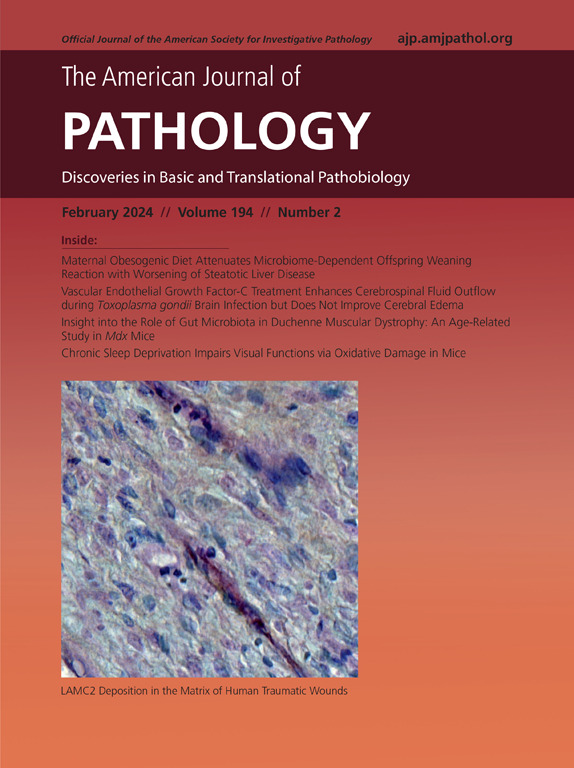Toll-Interacting Protein Down-Regulation by Cigarette Smoke Exposure Impairs Human Lung Defense against Influenza A Virus Infection
IF 3.6
2区 医学
Q1 PATHOLOGY
引用次数: 0
Abstract
Cigarette smoking is a primary cause of chronic obstructive pulmonary disease (COPD). Smokers have a higher risk of influenza-related mortality, but the underlying mechanisms remain unclear. Toll-interacting protein (TOLLIP), an immune regulator, inhibits influenza A virus (IAV) infection, but its regulation in COPD has not been well understood. This study was designed to determine whether cigarette smoke (CS) exposure down-regulated TOLLIP expression via epigenetic mechanisms, including histone methylation. TOLLIP and histone-methylating enzymes enhancer of zeste homolog 1/2 (EZH1/2) were measured in healthy and COPD human lungs, human airway epithelial cells cultured under submerged and air-liquid interface conditions, and precision-cut lung slices (PCLSs) exposed to CS with or without IAV infection. EZH1/2 siRNA and inhibitors were used to investigate their effects on TOLLIP expression. In patients with COPD, TOLLIP levels decreased, whereas EZH1 and EZH2 expression increased. Repeated CS exposure decreased TOLLIP and increased EZH1, EZH2, trimethylation of histone H3 at lysine 27 (H3K27me3), and IAV levels in human airway epithelial cells and PCLSs. EZH1/2 siRNA or their pharmacologic inhibitor valemetostat tosylate, in part, restored TOLLIP and reduced IAV levels in CS-exposed airway epithelial cells and PCLSs. These findings suggest that repeated CS exposure during viral infection reduced TOLLIP levels and increased viral load in part through EZH1/EZH2-H3K27me3–mediated epigenetic mechanisms. Targeting EZH1 and EZH2 may serve as one of the potential therapeutic strategies to restore TOLLIP expression and host defense against viral infections in patients with COPD.

暴露于香烟烟雾中的TOLLIP下调会损害人体肺部对甲型流感病毒感染的防御能力。
吸烟是慢性阻塞性肺疾病(COPD)的主要原因。吸烟者有较高的流感相关死亡风险,但潜在的机制尚不清楚。toll -相互作用蛋白(TOLLIP)是一种免疫调节剂,可抑制甲型流感病毒(IAV)感染,但其在COPD中的调节作用尚未得到很好的了解。我们试图确定香烟烟雾(CS)暴露是否通过表观遗传机制(包括组蛋白甲基化)下调TOLLIP表达。在健康和慢性阻塞性肺病人肺、浸泡和气液界面条件下培养的人气道上皮细胞以及暴露于CS(有或没有IAV感染)的精确切割肺切片(PCLS)中测量TOLLIP和组蛋白甲基化酶EZH1/2。利用EZH1/2 siRNA及其抑制剂研究其对TOLLIP表达的影响。在COPD患者中,TOLLIP水平降低,而EZH1和EZH2表达升高。反复暴露CS可降低人气道上皮细胞和PCLS的TOLLIP水平,增加EZH1、EZH2、H3K27me3和IAV水平。EZH1/2 siRNA或其药理抑制剂tosylate valemetostat部分恢复了cs暴露的气道上皮细胞和PCLS的TOLLIP并降低了IAV水平。我们的研究结果表明,在病毒感染期间,反复暴露于CS会降低TOLLIP水平,并部分通过EZH1/ ezh2 - h3k27me3介导的表观遗传机制增加病毒载量。靶向EZH1和EZH2可能是恢复COPD患者TOLLIP表达和宿主防御病毒感染的潜在治疗策略之一。
本文章由计算机程序翻译,如有差异,请以英文原文为准。
求助全文
约1分钟内获得全文
求助全文
来源期刊
CiteScore
11.40
自引率
0.00%
发文量
178
审稿时长
30 days
期刊介绍:
The American Journal of Pathology, official journal of the American Society for Investigative Pathology, published by Elsevier, Inc., seeks high-quality original research reports, reviews, and commentaries related to the molecular and cellular basis of disease. The editors will consider basic, translational, and clinical investigations that directly address mechanisms of pathogenesis or provide a foundation for future mechanistic inquiries. Examples of such foundational investigations include data mining, identification of biomarkers, molecular pathology, and discovery research. Foundational studies that incorporate deep learning and artificial intelligence are also welcome. High priority is given to studies of human disease and relevant experimental models using molecular, cellular, and organismal approaches.

 求助内容:
求助内容: 应助结果提醒方式:
应助结果提醒方式:


